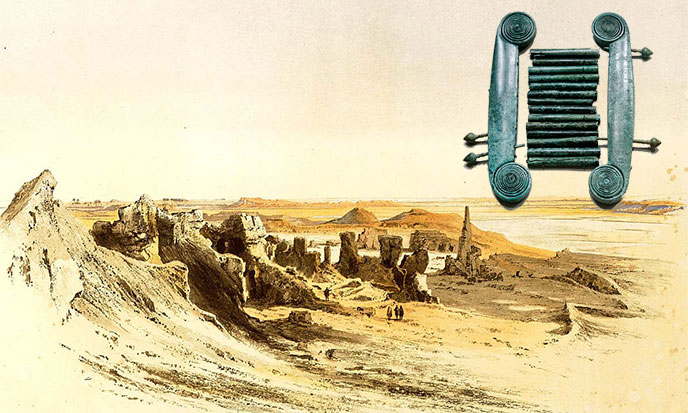
“The first Egyptian temple was built in Sais 16,000 years ago. This date is accurate because it was built by Thoth early in the history of Egypt, a fact which is confirmed by a tablet discovered by Schliemann in Crete, on which we read: “The early Egyptians were led by Atlantean Thoth, the god of history. They settled on the banks of the Nile at Sais where they built their first temple.” (Source)James Churchward, the secret world of Mu
These lines were written by James Churchward -also called Colonel- who is the father of the theory of Mu, sunken continent in the Pacific Ocean. He has devoted several books to Africa he calls the Motherland.
In the small world of the adventurers of the distant past, Colonel James Churchward is definitely a great name. Like Thor Heyerdahl, Robert Charroux or Erich von Däniken, the Colonel Churchward is one of the pioneers of new look archeology when non-academic but highly publicized explorers thought they were Indiana Jones, moreover not yet invented.
Undoubtedly one of them has been used as a model, although Spielberg claims to have imitated Tintin, yes, the little Franco-Belgian reporter. But Tintin never wore Indy hat, when the others did.
If there is a pioneer of archeology worthy to inspire the character of Indiana Jones, it’s Heinrich Schliemann. Oh so romantic a discoverer of the archaeological site of Troy, he walked through the Turkish hills handling his copy of the Iliad, he used the Homer verses to reconstruct the battle field.
Schliemann ran several times around a certain hill as Achille ran around Troy, and excavations have revealed no fewer than seven towns built one above the other under this very hill. He concluded that Troy was the fourth, why not, God saves Indiana Jones.
But Colonel Churchward tells us that Schliemann son Paul made incredible discoveries during his excavations at Sais, Egypt. He tells us himself.
“We dug the ground for five months to discover the ruins of the ancient temple of Sais, Egypt. Among other interesting things, we have unearthed a burial chamber of musical celebrities of the time. In a catacomb of 3rd Dynasty, we found a very unusual collection of musical instruments. It also contained a papyrus that has not yet been deciphered, but I feel that it is written in an Egyptian musical language still unknown. An inscription in hieroglyphics said that musical instruments belonged to the orchestra of the Sais temple and they were used for the coronation of Pharaoh Amenemhat I.
These instruments mimic, for example, the roar of wind, the sea waves, the song of certain birds and various mysterious voices. (…) Getting found a huge wooden trumpet that produces the sound of the roaring lion, while their flute launches the softest sounds they have ever heard. It has a mesmerizing timbre, magical, even if we do not play a single note.
(…) These instruments are made of wood or porcelain. There is only one copper or that kind of metal. The strings of their harps are made of a material completely unknown nowadays. They are extremely thin and resistant, and resemble silver wire. There are others that have been spun with long hair taken from the head of a beauty.
To run the majestic hymn to the sun, it should not be less than seventy-five musicians and eighty singers. The instrument that seems the most important products hollow, monotonous sound, quite mesmerizing. This instrument is made of a human skull dug to evoke the throat of some supernatural monster.
It is obvious that this instrument had an incalculable sounds register, he played in the orchestra a unique role. An inscription on the smallest bones tells us that it could produce not only the sound of other instruments but also that of the human voice. It was called the dead throat.” (Source)Paul Schliemann, quoted by James Churchward, the secret world of Mu
Yes, that instrument had a special role as the soloist. Or more precisely the maestro, leader of trance. Because we recognized the musical instruments of trance, with the sweetness of the flute and the roar of the wind. The author points to the wind and string instruments, but it tells us nothing percussion. But there must be an orchestra of this type. I distinctly hear the sound of this dead throat.

It is similar to the deep chant of the didgeridoo. But he was music folds, its register is infinitely extended, it can produce telluric rumblings that vibrate the ground under the feet of the dancers, or exhaling a complaint that the sweetness would melt a heart of stone.
Praise Schliemann for this discovery, essential to musicologists, the sonologistes and fans of trance trippy. I see the dances that go with it. Splendid. As Jean-Paul Sartre and Bigard, I am wary of trance without dancing. They are right in their delirium. The one will forget more quickly.
Who still remembers our masters? Who remembers gods before? A Churchward, to Schliemann, Charroux, Von Daniken, Heyerdahl, all pioneers of archaeo-dream, I take my hat off to doves. They were right, they tore the veil of Isis, now it only has to pull to get naked.
Isis, pagan virgin, virgin and genetic mother, wife and mother of Horus, daughter and wife of Osiris, wide awake, master of lightning, outstanding geneticist, lover of alchemy, last of the Matriarchs.
While Schliemann brilliantly concluded: “The Egyptians brought the culture of Atlantis to their colony of the Nile I found during my various excavations that Egypt is more ancient, the more it is cultivated the nation.. simply degenerated after the disappearance of Atlantis.” (source)Paul Schliemann, quoted by James Churchward, the secret world of Mu
I would not have said it better. Plato would add that Atlantis disappeared 12,500 years ago. Egypt has steadily declined since then. Like everything else on the planet, as our ambitions, as our strength, as our talents as our powers.


